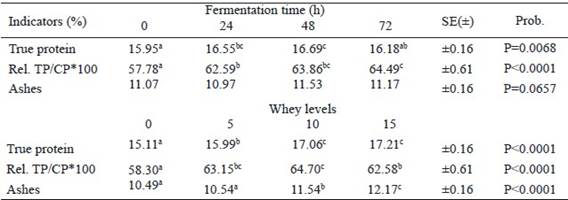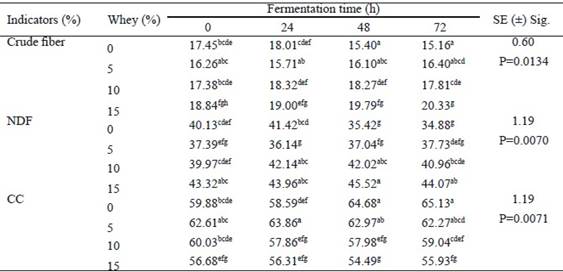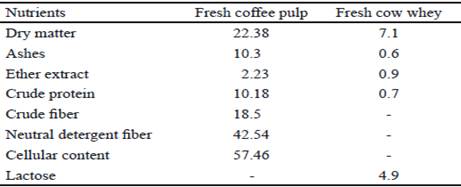The use of agro-industrial residues by-products in animal feed is a trend in the new millennium (Martin 2009). This practice contributes to reduce environmental pollution (Saval 2012), helps improve the diet of animals and also allows to increase technical and economic indicators in livestock production systems (Gómez et al. 2013).
The benefit of moist coffee (Coffea arabica L.) generates large volumes of pulp. According to several authors (Bressani et al. 1972, Ramírez et al. 1999, Morgan 2003, Munguía 2015 and Pinto et al. 2017), coffee pulp has an appreciable nutritional value. However, its high content of humidity, fiber and anti- nutritional substances limits its use as a single diet in animal feed (Noriega et al. 2009), so it needs a previous process of transformation.
Solid state fermentation (SSF) allows to improve the nutritional quality of agricultural residues. From the use of carbohydrates and in the presence of a nitrogen source, the synthesis of microbial protein, the reduction of anti-nutritional substances, as well as the improvement of their organoleptic characteristics are achieved (Chávez et al. 2009, Peláez et al. 2011 and Palmerín et al. 2011). Growth and development of the epiphytic microflora present in the substrate can be enhanced by the addition of non-protein nitrogen, easily fermented carbohydrates and minerals (Elías et al. 1990, Valiño et al. 1998 and Rodríguez 2004). Morgan (2003), through SSF, with addition of 10 % of molasses, 1.5 % of urea and 0.5 % of mineral salts, obtained an enriched coffee pulp, with a chemical composition of 91.15 % of residual DM, 23.5 % of CP, 16.4% of true protein, 20.5 % of CF and 17.8 of ash.
In Loja province, Ecuador, the availability of coffee pulp and by-products like whey, which are low- cost and have a limited use in animal feed, is high. The objective of this study was to evaluate the effect of the inclusion of different levels of whey in the SSF of coffee pulp, to contribute to improve its nutritional value and facilitate its use in ruminant feeding.
Materials and Methods
Location. The experiment was conducted in the bromatology laboratory of the National University of Loja, Ecuador, located at south west of Loja city, at an altitude of 2,160 m.o.s.l., mean temperature of 16.2 ºC, mean annual precipitation of 1,338 mm and relative humidity of 76% (INAMHI 2014).
Treatments and experimental design. The effect of the inclusion of whey in the SSF of coffee pulp was evaluated by a completely randomized design, with a 4 x 4 factorial arrangement. Factor A corresponded to whey levels (0, 5, 10 and 15 %) and B, to fermentation time (0, 24, 48 and 72 hours).
Obtaining experimental material. Coffee pulp corresponded to Coffea arabica species, Typica variety. It was obtained in the plant of the Asociación Agro-artesanal de Productores Ecológicos de Café Especial (APOCAEL), located in the parish of San Pedro de Vilcabamba, in Loja canton (Ecuador). The residue was obtained on the third day of the pulping by stratified sampling. Later, it was taken to the laboratory in a polyethylene container. Whey, used as a source of easily fermented carbohydrates, corresponded to a fresh by-product, obtained in the processing of cow milk for the production of fresh cheese, with the use of enzymes, which is why it is also known as sweet serum. Table 1 shows the bromatological composition of the fresh coffee pulp and whey used in the experiment.
Experimental procedure. The SSF was carried out in Erlenmeyer flasks of 1000 mL, each one was an experimental unit. Three repetitions were used for each treatment. Based on the experimental treatments, 100 g of the substrate were weighed, which included coffee pulp and whey (W), accordingly. An amount of 1.5 % of urea and 0.5 % of mineral salts was added to all treatments. It was incubated at 26 °C during the established periods. For the determination of fermentation indicators, samples were taken according to the methodology of Elías et al. (1990). The pH was measured with portable digital potentiometer of four digits (ATC brand) and ammonia, according to the McCulloug (1967) technique, with absorbance readings at 650 nm. A Shimadzu UV 1800 spectrophotometer was used for this purpose.
The rest of the fermented product was brought to the oven for dehydration at 65 °C. After grinding, the bromatological analysis was carried out. Dry matter (DM), ash (A), crude fiber (CF) and crude protein (CP) were determined according to AOAC (2005) procedures and true protein (PV) by Bernstein (1970). Neutral detergent fiber (NDF) and cellular content (CC) were calculated according to the procedure of Goering and van Soest (1970).
Statistical analysis. Data was processed with Insfostat V2 statistical package (Di Rienzo et al. 2012). To determine the difference among means, Duncan (1955) test was applied.
Results and Discussion
The SSF of coffee pulp with different whey levels (0, 5, 10 and 15 %) and fermentation time (0, 24, 48 and 72 h) revealed interaction in some indicators such as NH3, DM, CP, CF, NDF and CC, not so in pH, TP and ash.
Table 2 shows the performance of pH. According to fermentation time, it remained stable until 48 h, and increased 0.77 units at 72 h (P <0.001). Regarding the levels of inclusion of whey (W), there was no change in pH at lower levels, with values close to 5. This could probably be a result of the accumulation of the pulp in the plant for three days, which favored its natural fermentation. This state generated organic acids from the present carbohydrates, which was evidenced in the metabolic heat in the pile. However, at the 15 % level of W, the pH increased by 1.32 units, with respect to the treatment without W. This could be explained by the increase of NH3, product of the deamination of urea and other amino acids present in the whey or also by the decrease in the concentration of short-chain fatty acids (SCFA), as a result of the synthesis of microbial protein.
Table 2 Effect of whey (W) on pH during the dynamics of SSF of coffee pulp

abc Different superscripts indicate significant differences (P<0.05), Duncan (1955)
Pulido et al. (2016) also reported of increases in pH over time in the SSF of pear residues (40% pear, 25% rice meal, 25 % wheat bran and 10 % urea), as well as Borras et al. (2017) in the SSF of potato residues, inoculated with a microbial preparation and the inclusion of 15 % of fiber materials, although the values at 48 h did not exceed 5.2. However, Morgan (2003), in the SSF of coffee pulp with different levels of final molasses, obtained a pH increase at 48 h, with values close to alkalinity. Brea et al. (2015) in the SSF of breadfruit tree meal and Chafla (2016) in cocoa peel with different levels of urea, also reported alkaline pH values.
The pH values obtained in this study are within the appropriate ranges for the growth of microorganisms in SSF processes. According to Pandey et al. (2001) and Elías et al. (2001), these should be maintained between 3.5 and 6.
The NH3 content (table 3) was lower (9.66 meq/L) at zero hour in the absence of W (P=0.0013). Meanwhile, at 48 h and with the addition of 15% of W, the highest content was recorded with 48.59 meq/L. In the absence of W, NH3 was not modified until 48 h. Then, it was increased 2.6 times at 72 h with respect to zero hour. With 5% of inclusion, it was maintained until 24 h and increased at 48 h. It was stable until 72 h. With 10 % of inclusion, it was modified at 24 h and then stabilized until 72 h. Finally, with a 15 % of W inclusion, the highest peak of NH3 was reached at 48 h, and then, it decreased and stabilized at 72 h.
Morgan (2003) also reported the interaction of the factors under study in the SSF of coffee pulp, with the inclusion of different levels of final molasses (0, 5 and 10 %), as well as Brea et al. (2015), although with inferior values. Borras et al. (2017), in the SSF of potato residues, inoculated with a microbial preparation and with the inclusion of 15 % of fiber materials, observed that NH3 concentration is reduced with the time of fermentation. These differences in the results of cited authors could be related to the nature of the used substrates.
Table 3 Effect of whey (W) on NH content during the dynamics of SSF of coffee pulp

abcdefgDifferent superscripts indicate significant differences (P<0.05), Duncan (1955)
Several studies of SSF in sugarcane and cane bagasse (Elías et al. 1990, Valiño et al. 1996, Valiño et al. 1997, Valiño et al. 1998, and Rodríguez et al. 2001) affirm that there is a direct relationship between pH and the concentration of NH3. However, in this experiment, this relationship was not found, which could be due to the presence of organic acids in the substrate. As it was previously stated, a natural fermentation process was started in the pile due to the high content of sugars and pectins of easy and rapid fermentation, which generated SCFA that were not determined, and the combination of both metabolites establish the pH (Rodríguez 2004).
Table 4 shows the variations in DM and CP content. Fermentation began with approximate values of 4 % of DM. At 72 h, the lowest value (17.8) was recorded at the 15 % level of W. In general, there was a decrease of dry matter, as the fermentation time progressed (P <0.001), which was probably associated to the transformation of soluble carbohydrates into SCFA that are used as an energy source for maintenance and growth of microbial population (Rodríguez 2004). Likewise, Valiño et al. (1997), Morgan (2003) and Rodríguez (2004) mentioned that aerobic microbial fermentation of soluble carbohydrates originates CO2 and H2O that increase humidity and, consequently, cause the decrease of DM. Another consideration to take into account is that the inclusion of W increases humidity and decreases the DM, which was evident at 15 % of inclusion.
DM performance in this study was also evident in other studies on SSF, developed by Morgan (2003), Brea et al. (2015) and Borras et al. (2017). However, they differ from those reported by Chafla (2016), in the SSF of cocoa husk with different levels of urea, where there was an increase of 3.33 percentage units of DM, probably due to the fact that, because of the characteristics of the substrate, part of the contained water could be evaporated by the metabolic heat that is generated during the SSF process, because the studies were carried out for longer times.
The reduction of dry matter in this study caused an effect of relative concentration of the rest of indicators, expressed in percentage values with respect to it. This is the case of the CP, which is explained in table 4.
Table 4 Effect of whey on DM and CP content in SSF of coffee pulp up to 72 hours

abcdefghiDifferent superscripts indicate significant differences (P<0.05), Duncan (1955)
CP content decreased, approximately, 2.5 units at 72 h (P=0.0040). Meanwhile, the inclusion of W caused an increase (P<0.001) in the superior levels of inclusion, but without differences among them. This trend was maintained up to 72 h, probably due to the contribution made by this by-product.
Morgan (2003) and Chafla (2016) also reported a decrease in crude protein content in the SSF of coffee pulp and cocoa husk, respectively. While Brea et al. (2015), in the SSF of breadfruit tree meal, and Borras et al. (2017) in the SSF of potato residues, reported a different performance. That is, the CP increased over time, which could also be attributed to the characteristics of the substrates.
TP is directly related to protein synthesis processes at cellular cytoplasm level of microorganisms involved in the SSF, and is one of the nutrients of greatest value in animal nutrition. Table 5 shows the performance of TP, protein synthesis efficiency (Rel. TP/CP*100) and ash content. In this study, greater synthesis of TP was observed at 48 h (P=0.0068), with no difference detected compared to 24 h. While, according to W inclusion levels, 10 and 15 %, revealed higher synthesis activity (P<0.0001), without statistical differences among them.
Table 5 Effect of whey on the content of TP, TP/CP relation and ashes during the dynamics of SSF of coffee pulp

abcDifferent superscripts indicate significant differences (P<0.05), Duncan (1955)
Conversion indexes from CP to TP, expressed as a percentage, are related to TP values. According to time, greater anabolic activity was recorded as dynamics advanced, and exceeded the initial value by 6.7 units. According to inclusion levels, it is revealed that with 10 % of W, the maximum synthesis of TP is achieved (P <0.001), which corresponds to 64.7 %. A similar performance of protein synthesis in the time was referred by Morgan (2003) in the SSF of coffee pulp with different levels of final molasses. Likewise, Rodríguez et al. (2006), Ramos et al. (2007), Rodríguez-Muela et al. (2010), Brea et al. (2015), Chafla et al. (2016) and Borras et al. (2017) found similar responses, although with lower values because they were different substrates.
According to Pandey et al. (2001), TP can be an indirect path to measure microbial growth in SSF processes, since the mixed microbiota that is established in the system transforms the non-protein nitrogen (NPN) of urea into protein nitrogen (PN). The increases of TP obtained in this study confirm the effectiveness of microbial synthesis from carbohydrates and urea nitrogen.
According to Elías and Lezcano (1993), the efficiency with which the NPN of urea becomes PN varies in relation to the substrates used and the management of SSF, but above all with the availability of energy and carbon sources (soluble carbohydrates, starch and fats), amino acids, peptides, vitamins and minerals. Several authors (Elías et al. 1990, Valiño et al. 1996, Valiño et al. 1997, Valiño et al. 1998 and Rodríguez 2004) highlight the importance of urea as a nitrogen source and the value of easily fermented carbohydrates in the contribution of energy, to achieve superior efficiency in the synthesis of microbial protein. Its performance has a relation to pH dynamics and NH3, explained above.
The results indicate that the addition of W could have favored a superior synchronization between the presence of energy (SCFA) from fermentation of carbohydrates from the substrate and the ammonia nitrogen coming from urea hydrolysis. However, the presence of free amino acids, peptides and other growth factors, provided by whey cannot be discarded. All this contributes, possibly, to a higher synthesis of microbial protein.
Ash content (table 5) was not modified during the fermentation time, but it was increased by 1.68 units with 15 % of W inclusion, which could be related to the supply of minerals from the serum and the relative concentration produced by decreasing DM. Similar performances were reported by Morgan (2003), in the SSF of coffee pulp because, with the inclusion of increasing levels of final molasses, there was an increase of mineral content, but it did not vary with time. Pulido et al. (2016), in fermentation of pear residues, with inclusion levels of calcium carbonate and addition of rice meal, wheat bran and urea, evidenced a marked increase of ash content in relation to time, which probably was related to processes of relative concentration.
Robinson et al. (2001) reported the presence of phosphorus, sulfur and other minerals among the ashes that, in small quantities, are important for microbiota metabolism. Similarly, Elías and Lezcano (1993) demonstrated the importance of trace elements and vitamins of B complex for the accelerated growth of yeasts established during the SSF of sugarcane. For these reasons, it is necessary to highlight the appreciable presence of ash (from 10 to 12 %) in the coffee pulp, which could favor the synthesis of microbial protein.
The performance of CF, NDF and CC is summarized in table 6. It was observed that in the absence of W up to 48 h, the CF content decreased, and then remained stable until 72 h. However, when W was used, regardless of the level, the CF indicators were not modified with time (P=0.0134). The highest increase (5.17 units) was observed at 15 % level at 72 h, which can be explained by the relative concentration of nutrients, which is a result of DM decrease. A similar trend was referred by Morgan (2003) in coffee pulp fermentation, and Pulido et al. (2016) in pear residues.
Table 6 Effect of whey on the content of CF, NDF and CC in SSF of coffee pulp up to 72 hours (%)

abcdefghDifferent superscripts indicate significant differences (P<0.05), Duncan (1955)
Several authors (Rodríguez et al. 2001, Ramos 2005, Berradre et al. 2009 and Aranda et al. 2012) state that CF tends to increase over time, because the microorganisms present in the system use sugars of easy fermentation of cellular content, which significantly increases the content of cell walls in the substrate. These fiber elements have more complex structures, so they are the least degraded in SSF processes, when they are performed for relatively short periods of time and microorganisms with high cellulolytic capacity are not used.
Results for NDF and CC confirm the previous information. Thus, superior NDF content (45.52 %) was observed at 48 h in the 15% of W level, while the inverse performance is present in CC, with 54.49 % (P=0.0071). Similar results were reported by Morgan (2003) and Chafla (2016) in the fermentation of coffee pulp and cocoa husk, respectively.
Conclusions
It is concluded that the inclusion of 10 % of W in the SSF of coffee pulp up to 48 h improves the fermentation process, with marked increase in CP, TP and CP/TP relation. Although fiber components remain high, their use could be favorable in the preparation of rations for feeding ruminants.











 text in
text in 



